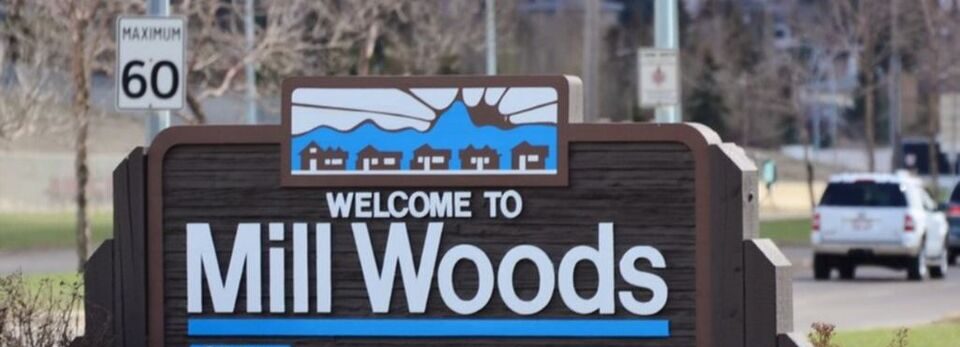Mill Woods Living Heritage

2025 Project Developments
While the Mill Woods Living Heritage project ended in 2017, historian Catherine C. Cole is now writing a book about the history of Mill Woods which will cover the early history of the area as the Papaschase Indian Reserve though to the 50 th anniversary of the land bank in 2019. Over the next year, she will be filling in gaps in the initial research and writing the manuscript. She is working to provide more opportunities for community input, including writing for the Mill Woods Mosaic beginning in January 2026, and expects to undertake a few more oral histories If you are interested in sharing your story or would like more information please contact her at catherinec.cole@telus.net
Mill Woods
To most Edmontonians, Mill Woods is considered a new suburb, far from the central core. Yet, the Mill Woods concept is now 50 years old and the community – if it were a city – would be the third largest in Alberta. Mill Woods is unique. Based on a city-planned and funded land assembly, it was designed and
built to provide quality, affordable homes to offset the inflationary impact of the second oil boom. Mill Woods was Edmonton’s first socially planned community, built on land owned by the city and developed to enhance a sense of community. The planning documents are quite visionary in tone.
The scale of the Mill Woods plan, with a town centre and eight surrounding communities each divided into multiple neighbourhoods, and the decision to take the street design ‘off the grid’ into crescents and connecting circular roads made the development unique. There are significant differences between communities, ranging from the initial development in Richfield to later construction in Jackson Heights. The design for mixed housing has created an urban landscape where single family homes rub shoulders with high rise apartments and condo complexes sit across a park from co-operatives.
The area is home to Indigenous people, migrants from other parts of Canada, and immigrants from places as diverse as South Asia, East Africa, the Philippines, the Caribbean, and Latin America. Diverse cultural communities embrace the Sikh parade, Caribbean ‘Mas Camps’ and Spanish language community dances, and celebrate their adopted home on Canada Day.
Our long-term goal is to improve understanding of and among diverse cultures in Mill Woods and between residents of Mill Woods and those in other parts of the city. The series of events which created this diversity is extremely complex. The establishment of the Papaschase Indian Reserve, controversial surrender of land to the federal government for settlement, creation of the land bank and design concept, and focus on affordable housing tell one narrative. But as changes in Canadian immigration policy and events in faraway places led to people immigrating to Mill Woods from around the world, the
story became multiple stories – stories that should be told.
Mill Woods Living Heritage
To most Edmontonians Mill Woods is considered a new suburb. Yet, the Mill Woods concept is now 45 years old and the community – if it were a city – would be the third largest in Alberta. Mill Woods is unique. Based on a city-planned and funded land assembly, it was designed and built to provide quality, affordable homes to offset the inflationary impact of the second oil boom. Mill Woods was Edmonton’s first socially planned community, built on land owned by the city and developed to enhance a sense of community. The planning documents are quite visionary in tone.
The scale of the Mill Woods plan, with a town centre and eight surrounding communities each divided into multiple neighbourhoods, and the decision to take the street design ‘off the grid’ into crescents and connecting circular roads made the development unique. There are significant differences between communities, ranging from the initial development in Richfield to later construction in Jackson Heights. The design for mixed housing has created an urban landscape where single family homes rub shoulders with high rise apartments and condo complexes sit across a park from co-operatives.
The area is home to Aboriginal people, migrants from other parts of Canada, and immigrants from places as diverse as South Asia, East Africa, the Philippines, the Caribbean, and Latin America. Diverse cultural communities embrace the Sikh parade, Caribbean ‘Mas Camps’ and Spanish language community dances, and celebrate their adopted home on Canada Day.
Our long-term goal is to improve understanding of and among diverse cultures in Mill Woods and between residents of Mill Woods and those in other parts of the city leading up to the 50th anniversary of the land bank in 2019. The series of events which created this diversity is extremely complex. The establishment of the Papaschase Indian Reserve, transfer of land to the federal government for settlement, creation of the land bank and original town plan, and concurrent social housing programs tell one narrative. But as changes in Canadian immigration policy and events in faraway places led to people immigrating to Mill Woods from around the world, the story became multiple stories.
Mill Woods Oral History Project
This history of Mill Woods is large and complex and will take years to fully explore. We are currently looking at ways to expand the number of communities represented in the oral histories and are particularly interested in interviewing members of Aboriginal, Filipino, and Sikh communities in the area. Please contact Ground Zero Productions for more information about the current status of the project or to become involved. Contribute your own stories of Mill Woods to our blog.